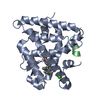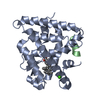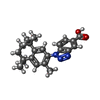Entry Database : PDB / ID : 6l6kTitle Crystal structure of dimeric RXRalpha-LBD complexed with partial agonist CBt-PMN and SRC1 Nuclear receptor coactivator 1 Retinoic acid receptor RXR-alpha Keywords / / / / Function / homology Function Domain/homology Component
/ / / / / / / / / / / / / / / / / / / / / / / / / / / / / / / / / / / / / / / / / / / / / / / / / / / / / / / / / / / / / / / / / / / / / / / / / / / / / / / / / / / / / / / / / / / / / / / / / / / / / / / / / / / / / / / / / / / / / / / / / / / / / / / / / / / / / / / / / / / / / / / / / / / / / / / / / / / / / Biological species Homo sapiens (human)Method / / / Resolution : 1.8 Å Authors Shimizu, K. / Numoto, N. / Nakano, S. / Makishima, M. / Kakuta, H. / Ito, N. Journal : To Be Published Title : Crystal structure of dimeric RXRalpha-LBD complexed with partial agonist CBt-PMN and SRC1Authors : Shimizu, K. / Numoto, N. / Nakano, S. / Makishima, M. / Kakuta, H. / Ito, N. History Deposition Oct 29, 2019 Deposition site / Processing site Revision 1.0 Nov 4, 2020 Provider / Type Revision 1.1 Aug 17, 2022 Group / Derived calculationsCategory database_2 / pdbx_struct_assembly ... database_2 / pdbx_struct_assembly / pdbx_struct_assembly_gen / pdbx_struct_assembly_prop / pdbx_struct_oper_list Item _database_2.pdbx_DOI / _database_2.pdbx_database_accession ... _database_2.pdbx_DOI / _database_2.pdbx_database_accession / _pdbx_struct_assembly.oligomeric_count / _pdbx_struct_assembly.oligomeric_details / _pdbx_struct_assembly_gen.oper_expression / _pdbx_struct_assembly_prop.value Revision 1.2 Nov 22, 2023 Group / Refinement descriptionCategory / chem_comp_bond / pdbx_initial_refinement_model
Show all Show less
 Yorodumi
Yorodumi Open data
Open data Basic information
Basic information Components
Components Keywords
Keywords Function and homology information
Function and homology information Homo sapiens (human)
Homo sapiens (human) X-RAY DIFFRACTION /
X-RAY DIFFRACTION /  SYNCHROTRON /
SYNCHROTRON /  MOLECULAR REPLACEMENT / Resolution: 1.8 Å
MOLECULAR REPLACEMENT / Resolution: 1.8 Å  Authors
Authors Citation
Citation Journal: To Be Published
Journal: To Be Published Structure visualization
Structure visualization Molmil
Molmil Jmol/JSmol
Jmol/JSmol Downloads & links
Downloads & links Download
Download 6l6k.cif.gz
6l6k.cif.gz PDBx/mmCIF format
PDBx/mmCIF format pdb6l6k.ent.gz
pdb6l6k.ent.gz PDB format
PDB format 6l6k.json.gz
6l6k.json.gz PDBx/mmJSON format
PDBx/mmJSON format Other downloads
Other downloads 6l6k_validation.pdf.gz
6l6k_validation.pdf.gz wwPDB validaton report
wwPDB validaton report 6l6k_full_validation.pdf.gz
6l6k_full_validation.pdf.gz 6l6k_validation.xml.gz
6l6k_validation.xml.gz 6l6k_validation.cif.gz
6l6k_validation.cif.gz https://data.pdbj.org/pub/pdb/validation_reports/l6/6l6k
https://data.pdbj.org/pub/pdb/validation_reports/l6/6l6k ftp://data.pdbj.org/pub/pdb/validation_reports/l6/6l6k
ftp://data.pdbj.org/pub/pdb/validation_reports/l6/6l6k
 F&H Search
F&H Search Links
Links Assembly
Assembly

 Components
Components Homo sapiens (human) / Gene: RXRA, NR2B1 / Plasmid: PET28A / Production host:
Homo sapiens (human) / Gene: RXRA, NR2B1 / Plasmid: PET28A / Production host: 
 Homo sapiens (human) / References: UniProt: Q15788*PLUS, histone acetyltransferase
Homo sapiens (human) / References: UniProt: Q15788*PLUS, histone acetyltransferase X-RAY DIFFRACTION / Number of used crystals: 1
X-RAY DIFFRACTION / Number of used crystals: 1  Sample preparation
Sample preparation SYNCHROTRON / Site:
SYNCHROTRON / Site:  Photon Factory
Photon Factory  / Beamline: BL-1A / Wavelength: 1 Å
/ Beamline: BL-1A / Wavelength: 1 Å Processing
Processing MOLECULAR REPLACEMENT
MOLECULAR REPLACEMENT Movie
Movie Controller
Controller


 PDBj
PDBj
















